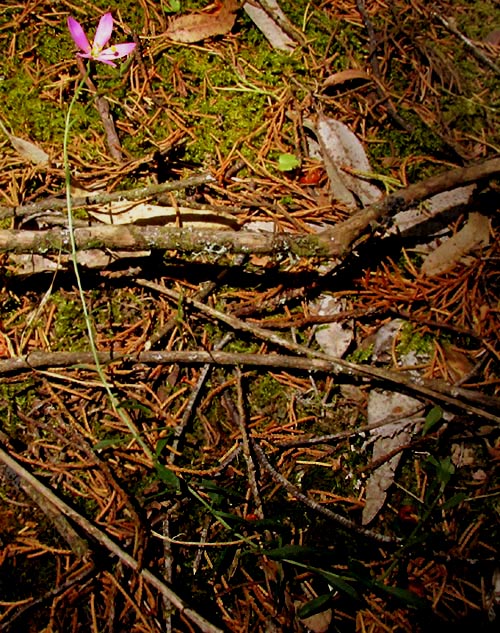Excerpts from Jim Conrad's
Naturalist Newsletter
entry from field notes dated April 14, 2022, taken in disturbed/reforesting borderline cloudforest within 1km of Valle de los Fantasmas, elevation ±2,320m (7600 ft), with limestone bedrock; about 40kms (24 miles), straight-line, ESE of San Luis Potosí, San Luis Potosí state, MÉXICO, (N22.06°, W100.62°)
GYRANDRA CHIRONIOIDES

Looking for a spot to camp overnight, I climbed toward a densely forested patch on the much-disrupted landscape. The dark green patch turned out to consist of Mexican Cedar trees, Cupressus lusitanica, planted on the steep slope in close ranks and files maybe 25 years ago. It looked like the whole mountain had been completely deforested, then the cedars were planted to bring the inevitable erosion under control. Here and there on the slope, where the cedars were widely spaced, car-size carpets of moss and fallen cedar-stem duff were illuminated by light entering the opening. In a few such clearings, two or three of the above small flowers nodded on slender stems like magenta sparks amid the plantation's somber shadiness.
From a distance, the blossoms seemed suspended in mid air, but up close you could see their spindly stems and small leaves, as shown below in a plant momentarily illuminated by a shifting sunbeam.

Below, you can see the plant's modest, narrow leaves arising opposite one another on somewhat squared stems. This particular stem was mostly lying on the ground, but others stood upright.

The blossom's form, color and structure reminded me of Sabatia campanulata, the Slender Rose Gentian I grew up knowing in Kentucky. The above blossom has fused sepals and petals like the Gentian Family, and opposite leaves like most species in that family, so back at the computer I began looking for members of the Gentian Family occurring in the arid central Mexican highlands. One feature shown in the above blossom was especially unusual, which helped a lot: The five yellow anthers are twisted into spirals.
In both the authoritative online Flora del Bajío and the Flora de Vera Cruz, those spiraling anthers led me right to the genus Centaurium. Online, some pictures showing plants looking like ours turned up taken here in San Luis Potosí state, labeled as Centaurium chironiodes. However, when I browsed around, pictures labeled as other Centauarium species also appeared to look like our plant.
Happily, in 2004, Guilhem Mansion published "A new classification of the polyphyletic genus Centaurium Hill (Chironiinae, Gentianaceae): description of the New World endemic Zeltnera, and reinstatement of Gyrandra Griseb. and Sheckia Griseb." In that work, the genus Centaurium was split into four genera.
In Mansion's very helpful paper, noting our spiraling anthers and non-spiraling stigma, and the lack of a rosette of leaves at the plant's base, our plant keyed out to the newly resurrected genus Gyrandra. The genus Gyrandra, by the way, is the "sister taxon" -- the closest relative -- of the genus Sabatia, in which the rose gentian I grew up with in Kentucky is found. No wonder this Mexican plant seemed so familiar!
And then Mansion's Gyrandra key and species distribution descriptions led to GYRANDRA CHIRONIOIDES, the former Centaurium chironiodes we first noticed on the Internet. Gyrandra chironioides has no common name. It's a narrowly endemic species just found in Mexico's Sierra Madre Oriental mountains, where it's documented from the states of Nuevo León, Tamaulipas, Hidalgo and here in San Luis Potosí. It's described as inhabiting pine forests at elevations between 1800-2500 meters (5900-8200 feet).
It's gratifying to be adding to the documentation of such a pretty little being. Also, it's good seeing the species coming back onto a mountain slope whose forest was totally obliterated 25 years ago. How the plants managed to return would be a wonderful story to know.